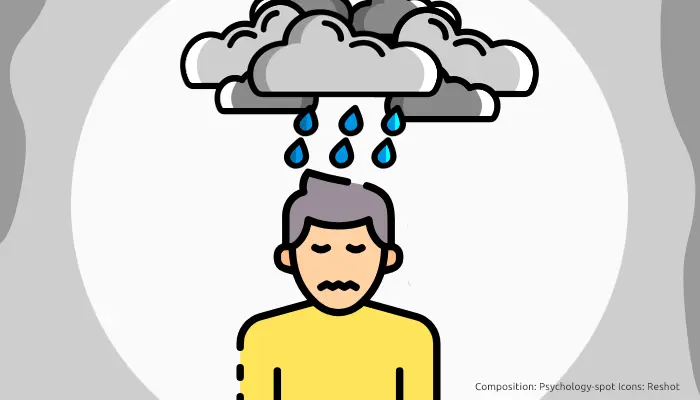
If adversity has knocked on your door, forcing you to face a particularly difficult situation and you feel sad, unmotivated or even disconnected from the others and from yourself, it is likely that you are suffering from reactive depression, a condition that is little talked about but which It can be devastating for those who suffer from it.
What is reactive depression exactly?
Depression is a mood disorder that affects our thoughts, feelings and behaviors. It manifests itself through symptoms such as deep sadness, demotivation, apathy, anhedonia, loss of meaning in life and inability to experience pleasure.
Many of us may feel this way at certain times, but people with a depressive disorder experience these symptoms for at least two weeks almost daily, so they end up affecting their daily lives and considerably worsen their mental health and well-being.
Reactive depression, also called situational depression, is a response to a significant life event that we find difficult to deal with. Basically, it is a reaction to an external problem or a highly stressful factor.
The concept was introduced in 1920 by Kurt Schneider, who established a binary model in which there was endogenous depression (in which it is difficult to identify a specific triggering event and internal factors have more weight in its etiology) and reactive depression (in which the cause is fundamentally external).
Currently, reactive depression falls under the umbrella of adjustment disorders, with the distinctive feature that there is a triggering event that causes a particularly distressed mood. That is, it is understood as a negative emotional reaction that goes beyond the normal limits of sadness in the face of a life event.
What causes reactive depression?
To refer to reactive depression, it is essential that the triggering factor can be identified; that is, the stressful experience that has caused the symptoms, which can be anything from a divorce to the death of a significant other or the loss of a job.
However, it is worth clarifying that the circumstances and events that can cause reactive depression are not always negative. In some cases, positive changes in life also generate so much stress that they end up triggering reactive depression.
It could be a pregnancy, a move, starting college, getting married, or starting a new work project. Although positive changes generate enthusiasm, they can also be a source of stress and provoke contradictory feelings such as fear, activating the feeling of loss and sadness.
This means that reactive depression does not only occur when we are exposed to an adverse situation, but also has a psychological factor since it depends on the way we perceive our environment. If we believe that we do not have the necessary resources to deal with this change or it generates too much uncertainty, we are likely to become stressed and open the door to depression.
Therefore, the event that may trigger reactive depression in one person may not trigger it in another since, ultimately, it will depend on their coping resources.
How does reactive depression manifest? The symptoms you should know
Each person reacts to stress and change differently, but some of the most common symptoms of reactive depression are:
• Deeper emotional changes than usual, such as feeling particularly sad, irritable, or in a bad mood
• Decreased energy level, which translates into apathy, demotivation and loss of interest in the things you used to like
• Changes in thinking, you begin to see everything black, through a pessimistic lens, and you experience some confusion and mental fog, as if you were having a hard time thinking clearly
• Neglecting usual responsibilities, because you feel that they have lost their purpose or you simply do not have the energy to carry out those tasks
• Changes in daily habits, from problems falling asleep or not wanting to get out of bed to loss of appetite and abandonment of healthy routines
• Social isolation, since you don’t feel like sharing with close friends or family
• Decreased performance, whether in studies or at work, so that you are more prone to making mistakes and feel that everything costs you double or triple the effort
• Physical pain, such as more frequent headaches, gastrointestinal discomfort or muscle tension
It should be noted that when these symptoms are mild, in response to a particularly stressful situation, they can be considered a normal reaction, so they are not a cause for concern. However, when they worsen or become persistent, attention must be paid to them.
In general, the symptoms of reactive depression usually disappear as the situation improves or as we adapt to the change, but in some cases they can worsen, giving rise to a more chronic condition, such as major depression.
What is the treatment?
Official Psychology does not usually recognize the distinction between reactive and endogenous depression, since both are the result of a mixture of external and internal factors. However, the truth is that the weight of these factors varies. In fact, a study conducted at King’s College London found that “Endogenous and reactive depression subtypes are associated with very different changes in gene expression.”
On a practical level, these results suggest that treatment should also be different, so that the severity of the symptoms should not be used as the only criterion. In this sense, another very interesting research carried out at Keiō University revealed that in their practice, Japanese psychiatrists make a distinction between endogenous and reactive depression.
As a result, 85% of these psychiatrists believe that depression medications are appropriate for patients suffering from endogenous depression, but only 40% think they are beneficial for those with reactive depressive symptoms. This distinction leads them to follow different treatment strategies in terms of psychopharmacology and psychotherapy.
In fact, for reactive depression, cognitive-behavioral therapy can be particularly effective as it helps people identify the thoughts that fuel the depressive condition and put more adaptive ideas in their place, in addition to teaching them techniques to deal with the stressful situation that has generated the problem.
References:
Malki, K. et. Al. (2014) The endogenous and reactive depression subtypes revisited: integrative animal and human studies implicate multiple distinct molecular mechanisms underlying major depressive disorder. BMC Medicine; 12: 73.
Mizushima, J. et. Al. (2013) Melancholic and reactive depression: a reappraisal of old categories. BMC Psychiatry; 13: 311.
Hirschfeld, R. M. (1981) Situational depression: validity of the concept. Br J Psychiatry; 139: 297-305.



